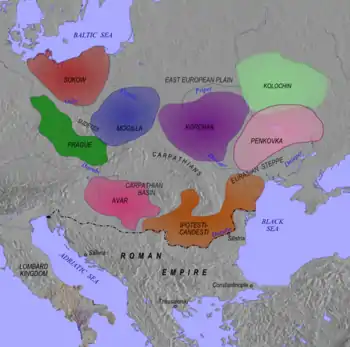Sukow-Dziedzice group
The Sukow or Sukow-Dziedzice group (German: Sukow-Dziedzice-Gruppe) or Sukow-Dziedzice culture (Polish: Kultura Sukow-Dziedzice, Russian: Суковско-дзедзицкая культура), also known as Szeligi culture, was an archaeological culture attributed to the Early Slavs. Areal of sites lays between Elbe and Vistula rivers in Northeast Germany and North West Poland. The earliest sites date to the second half of 7th and mid-8th centuries.[1][2]

There exist different views on its origin. It has features of both Przeworsk culture and Prague-Korchak culture. In comparison to Carpathian Slavic-speaking population of Korchak-Mogilany-type some consider Sukow-Dziedzice's had different population, maybe indigenous to Poland or arrived from within Poland and Belarus or a mixture of Korchak Slavs and indigenous post-Przeworsk population.[3] M. Kazanski identified the 6th-century Prague-Korchak culture and later Sukow-Dziedzice group as Sclaveni archaeological cultures, and the Penkovka culture (Prague-Penkovka) was identified as Antes.[4]
Later stages
The old theory mainly represented by Joachim Herrmann who argued 7th century second wave immigration origin of later archaeological groups which replaced Sukow is rejected by now. In that period arrived first Slavic people of Sukow culture who didn't build yet strongholds.[5][6][7][8][9]
- Feldberg-type, also known as Feldberg-Kędrzyny or Feldberger-Gołańcz-Kędrzyny in Poland,[10] appeared mainly in Pomerania and Mecklenburg, but also Little Poland and Southern Silesia, from mid-8th to late 9th century but in some parts was preserved until 9-10th century.[11][12] Based on data collected, L. R. Lozny in 2013 considered that a minor percentage already appeared in the end of 7th and early 8th century.[13]
See also
References
- Joachim Henning: Mecklenburg-Vorpommern und die Dendrochronologie zu slawischen Besiedlungsgeschichte Ostmitteleuropas - "Verwicklungen" und "Verwirrungen". Nitra 2004, S. 129–135, hier S. 133.
- Lozny, 2013, pp. 71–78
- Heather, 2009, pp. 412–414, 419, 426, 430–434, 449
- James 2014, p. 96.
- Barford, 2001, p. 65, 89
- Brather, 2004, p. 315–316
- Biermann, 2011, p. 167
- Fred Ruchhöft (2008). Vom slawischen Stammesgebiet zur deutschen Vogtei. Die Entwicklung der Territorien in Ostholstein, Lauenburg, Mecklenburg und Vorpommern im Mittelalter. Leidorf, Rahden (Westfalen), p. 31, ISBN 978-3-89646-464-4
- Heather, 2009, pp. 409–410
- Lozny 2013, p. 43.
- Brather, 2004, p. 320
- Biermann, 2011, p. 152, 155, 157, 161, 167
- Lozny, 2013, pp. 71–72
- Brather, 2004, p. 320; Brather & Dulinicz, 2005, pp. 79–88; Brather, 2008, p. 56–58
- Lozny, 2013, pp. 73–72
Sources
- Barford, M. Paul (2001). The Early Slavs: Culture and Society in Early Medieval Eastern Europe. Cornell University Press. ISBN 9780801439773
- Biermann, Felix (2011). "Functions of the Large Feldberg Type Strongholds from the 8th/9th Century in Mecklenburg and Pomerania". Sprawozdania Archeologiczne (63), pp. 149–173
- Brather, Sebastian (2004). "The beginnings of Slavic settlement east of the river Elbe". Antiquity, Volume 78, Issue 300. pp. 314–329
- Brather, S. (2001; 2nd ed. 2008). Archäologie der westlichen Slawen: Siedlung, Wirtschaft und Gesellschaft im früh- und hochmittelalterlichen Ostmitteleuropa. Walter de Gruyter. ISBN 9783110206098
- Brather, S., Marek Dulinicz (2005). "Slawische Keramik. Elbslawen" in Germanische Altertumskunde Online. Volume 29. Walter de Gruyer, pp. 79–88. ISBN 3110183609
- Cvijanović, Irena (2013). "The Typology of Early Medieval Settlements in Bohemia, Poland and Russia". In Rudić, Srđan (ed.). The World of the Slavs: Studies of the East, West and South Slavs: Civitas, Oppidas, Villas and Archeological Evidence (7th to 11th Centuries AD). Istorijski institut. pp. 289–344. ISBN 978-86-7743-104-4.
- Dolukhanov, Pavel (2014). "The Slavs in Europe". The Early Slavs: Eastern Europe from the Initial Settlement to the Kievan Rus. Routledge. ISBN 978-1-317-89222-9.
- Heather, Peter (2009). "The Creation of Slavic Europe". Empires and Barbarians: The Fall of Rome and the Birth of Europe. Oxford University Press. pp. 412–414, 419, 426, 430–1, 434, 449. ISBN 978-0-19-975272-0.
- James, Edward (2014). Europe's Barbarians AD 200-600. Routledge. ISBN 978-1-317-86825-5.
- Lozny, R. Ludomir (2013). Prestate Societies of the North Central European Plains: 600-900 CE. Springer. ISBN 9781461468158
Further reading
- Brather, Sebastian (1995). "Nordwestslawische Siedlungskeramik der Karolingerzeit - Fränkische Waren als Vorbild?". Germania. Vol 73 (2), pp. 403–420
- Brather, Sebastian (1996). Feldberger Keramik und frühe Slawen: Studien zur nordwestslawischen Keramik der Karolingerzeit. Habelt. ISBN 9783774927681
- Sikora, J., 2007. Polska Centralna we wczesnym średniowieczu w świetle badań archeologicznych i osadniczych. Slavia Antiqua: rocznik poświęcony starożytnościom słowiańskim, (48), pp.125-160.
- Parczewski, M., 1988. Najstarsza faza kultury wczesnosłowiańskiej w Polsce (No. 141). Nakł. Uniwersytetu Jagiellońskiego.
- Wachowski, K., 2001. Elementy rodzime i obce w uzbrojeniu wczesnośredniowiecznym na Śląsku.
- Rogalski, B. and Messal, S., 2012. Frühe Slawen im Pyritzer Land. Erste Ergebnisse eines interdisziplinären Forschungsvorhabens. Materiały Zachodniopomorskie, 9, pp.127-206.
- Gruszka, B., Łuczak, A., Forysiak, J., Twardy, J., Gunia, P. and Milecka, K., 2015. Osada z VII i początku VIII wieku w Mozowie, stan. 23, woj. lubuskie. Źródła archeologiczne i środowiskowe.
- Messal, S. and Rogalski, B., 2013. Early Slavs in the Southwest. Baltic Region: Initial. Investigations in Dobropole. Pyrzyckie (Poland). Archaeologia Baltica, 17, pp.80-90.
- Lozny, L.R., 2017. Societal Dynamics of Prestate Societies of the North Central European Plains, 500–1000 CE: A Model. In Feast, Famine or Fighting? (pp. 35-59). Springer, Cham.